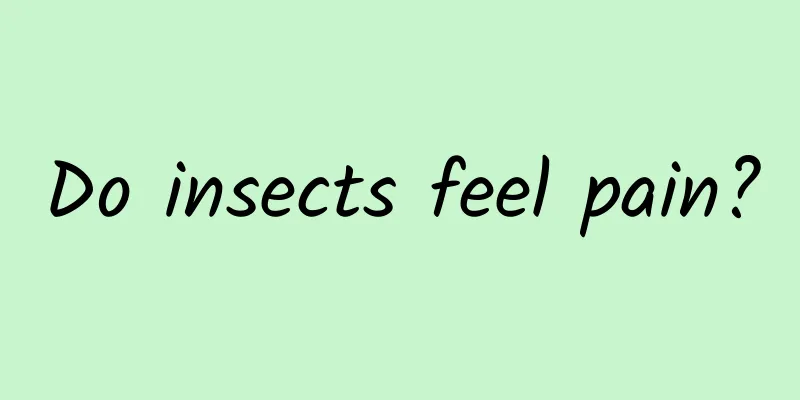Do insects feel pain?

|
Author: Gao Qi Reviewer: Yin Haisheng (Shanghai Entomological Museum, Chinese Academy of Sciences) As early as the last century, scientists have begun to study whether insects can feel pain. But to answer this question, we must first understand what pain is. The pain mentioned in modern medicine is a complex physiological and psychological activity. Pain can be divided into two parts: one is the uncomfortable physical pain caused by disease or stimulation, and the other is the psychological pain caused by trauma. In short, pain is a feeling that does not necessarily depend on the event that is happening at the time, but can also be caused by similar events in the past. Think back to when we were young and went to the hospital for injections. Before the doctor started injecting, he only applied disinfectant, alcohol, and iodine on our bodies. We already felt pain and wanted to avoid it. This is pain caused by trauma. Don't underestimate pain. In fact, pain is of great significance to us. Physiological pain allows us to understand the damage to our bodies. When you have severe pain in your body, we need to go to the hospital for examination and timely treatment. Psychological pain also has the ability to make people remember. For example, the pain caused by picking up a hot bowl with bare hands can prevent us from doing the same thing again, thus reducing damage to our body. It can be said that without pain, the probability of human death will increase significantly. Since pain is a feeling, how is the feeling formed? Friends who have studied biology seriously must still remember vaguely that the formation of feelings requires receptors to receive stimulation, which is then transmitted to our cerebral cortex by nerves, and finally pain is formed in the cerebral cortex. As invertebrates, insects have a similar basic structure to humans in their nervous systems. They have nerve cells with similar structures to ours, neural locks with similar functions to our spinal cords, and brains with different structures but similar functions to ours. From the perspective of receptors, insects can also sense stimuli that humans cannot, such as infrared and ultraviolet rays that are difficult for us to observe, and some odors that we cannot distinguish. In terms of the hardware of the nervous system, insects are obviously qualified, but it should be noted that just having a nervous system does not mean that they can feel pain. We may all know that after mating, the female mantis will eat the male; some slow-reacting Orthoptera insects will still use their antennae to clean their limbs normally even if they are injured, and will not run away immediately even if someone touches their wound while feeding. From this point of view, insects really don’t seem to know what pain is. Some people may say that when they were young, they pinched a grasshopper and it clearly struggled. Insects will have a stress response to external dangers, but that is not necessarily because of pain. Some scientists believe that insects have a short lifespan, usually only a few dozen days to a few months, and they do not have time to remember the pain and pass this memory on to their offspring. Surprisingly, other scientists, through a series of studies on fruit flies, have come to the opposite conclusion. The exoskeleton of a fruit fly has the same receptors as humans that sense pain, indicating that insects can indeed respond to external pain stimuli. After cutting off a leg of a fruit fly, nerve signals similar to human inflammatory pain were detected. After the broken limb has completely healed, this fruit fly will care more about and protect his leg than other uninjured individuals, which is very similar to the psychological pain caused by trauma we mentioned earlier. Another research institute has filmed an experimental video of a fruit fly larvae twisting its body to escape from a sharp object after being stimulated by a sharp object. Of course, even if fruit flies do feel pain, it doesn't mean that other insects do too. Currently, there are more than 1 million recorded insect species, accounting for 2/3 of the total number of known animal species, and many insect researchers discover new insect species every year. With so many species of insects, their responses to external risks are definitely not exactly the same. In general, insects such as fruit flies have pain receptors and can produce certain stress responses to pain. Scientists have provided relatively sufficient scientific evidence. However, many of the special life phenomena of insects mentioned earlier, such as why male mantises can be eaten without any reaction, still have not been perfectly explained. Some scientists speculate that some insects may have the function of blocking the transmission of pain nerve signals, automatically shielding the different feelings caused by pain. If we really want to explain the pain of all insects, it may still require scientists' unremitting efforts and research. Since science still can't explain it, why don't we try to use philosophy to explain this phenomenon. Have you heard of the color blindness paradox? The original question is, there is a person who has a strange color blindness. The two colors he sees are different from others. He sees blue as green, and green as blue, but he himself doesn't know that he is different from others. Others see the sky as blue, but he sees green, but he calls it the same as others; blue grass is green, but he sees blue, but he calls blue green, so he and others don't know that he is different from others. Then the question is, how can he know that he is different from others? So we can also imagine that although insects can respond to pain stimuli, do they feel the same pain as we do? Even if they are different, these stimuli can still make insects instinctively seek benefits and avoid harm, surviving in the cruel competition of nature and becoming the most diverse group in the world. This article is produced by Science Popularization China-Starry Sky Project (Creation and Cultivation). Please indicate the source when reprinting. |
<<: Chengdu and Chongqing: Dinosaurs are everywhere
>>: The victory of "foodies" began when our ancestors learned to cook...
Recommend
Detail page copywriting template with conversion rate over 85%!
Copywriting has always been a very popular job : ...
Oceans are turning into deserts! How can we avoid the destruction of fisheries under climate change?
In recent years, climate change has led to the fr...
I can't get on the plane if my phone is out of battery.
The Transportation Security Administration (TSA) h...
If I keep exercising, will I still have thick, black hair when I am 70?
Review expert: Peng Guoqiu, deputy chief physicia...
Eating carp, celebrating silkworms...there are so many interesting folk customs on New Year's Day!
New Year's Day is coming. As a Chinese festiv...
Will the strongest gamma-ray burst reveal these supernova "explosive materials"?
"We are in awe and feel very lucky to be abl...
Four reference types of in-depth learning objects in Android (strong reference, soft reference, weak reference, virtual reference)
[[429600]] Preface In Java, everything is conside...
It's an eyesore! After clicking on the information flow ad, I actually saw this...
I have talked about many information flow adverti...
Case | Analyzing the effective marketing strategy in the early stage of a product
Marketing is nothing more than three things: conn...
Analysis of Douyin AARRR Traffic Funnel Model
Before formally analyzing the traffic funnel mode...
36 lessons to help you become an Excel expert
Contents: /36 lessons to help you advance from a ...
Do you know? How to learn TCP protocol
TCP is currently the de facto foundation of the I...
Samsung thrives on memory chips, how can Chinese manufacturers break through?
Since the second half of last year, the prices of...
How to evaluate the stability and quality of an App?
"Crash", like "stuttering" an...
A "universal template" for excellent event planning
In the eyes of outsiders, event planners are well...









